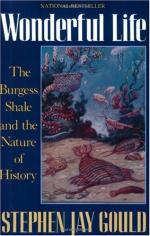
|
| Name: _________________________ | Period: ___________________ |
This test consists of 5 short answer questions, 10 short essay questions, and 1 (of 3) essay topics.
Short Answer Questions
1. What did Morris push Whittington to do?
2. What did Bruton and Whittington do in 1983 in a monograph?
3. Why is the Burgess Shale such an amazing find?
4. What large crab with an enormous number of spines did Collins publish a monograph on in 1985?
5. What did Gould note about the Burgess work at this time, in Act 5?
Short Essay Questions
1. What must the next generation do with the Burgess Shale?
2. What new view did Whittington hold after working on Naraoia?
3. What sort of series does Chapter 4: Walcott's Vision and the Nature of History transition to and why?
4. What does Gould note about the Burgess work and the Whittington, Briggs and Simon team?
5. Why is David Burton's published monograph on Sidneyia an important milestone?
6. What is uniquely special about the discovery of Sanctacaris?
7. How does the book describe Derek Briggs and Simon Conway Morris as students of Oxford?
8. How did Naraoia contribute to the Burgess Drama?
9. Describe Wiwaxia.
10. How can Odaraia be described?
Essay Topics
Write an essay for ONE of the following topics:
Essay Topic 1
Throughout Chapter 3 and Act 1, Gould delves into discussions of dominant paradigms. Cite three dominant paradigms, from any time period, that were associated with the Burgess Shale. Explain how these paradigms were discovered to be true or false. Explain you arguments with solid reasoning.
Essay Topic 2
In Chapter 1, Gould examines Walcott's inaccurate interpretation of the ladder and cone convention. Using this example, and others found in Chapter 1 or 2, agree or disagree with the following question: does Gould or Walcott present a more convincing argument concerning the ladder and cone interpretation? Present your paper with an arguable thesis that uses three solid examples from the book.
Essay Topic 3
How is the Burgess Shale a significant discovery for fossils and for the history of human development? Explain the author's reasoning using two examples from the book. Support your case with solid logic and either defend or oppose Gould's position.
|
This section contains 700 words (approx. 3 pages at 300 words per page) |

|




